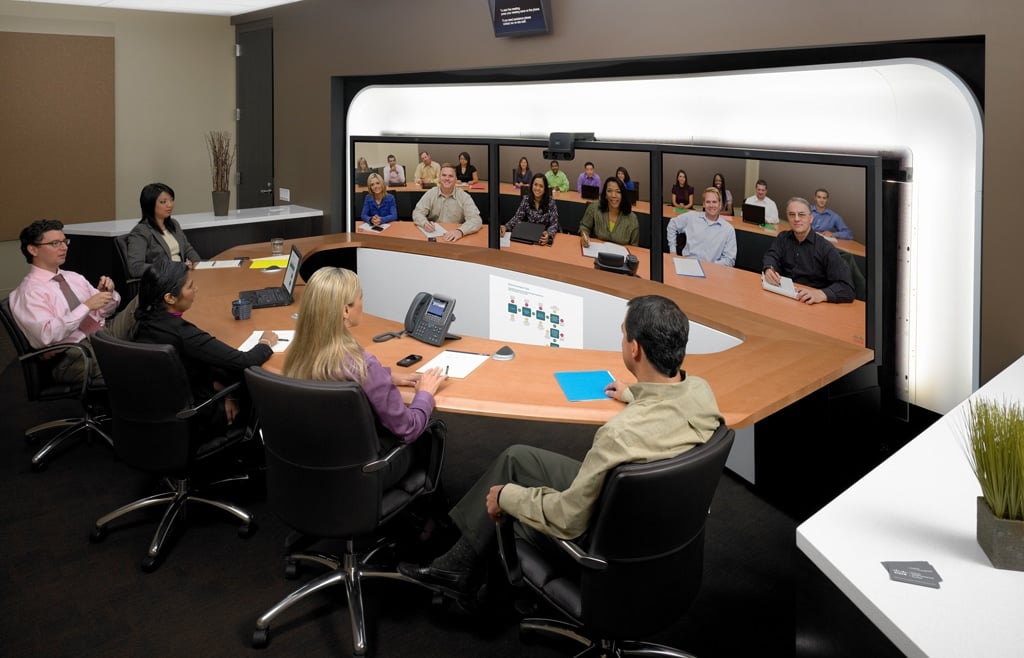The biggest problems that businesses face today aren’t limited to the problems related to hiring, marketing, or revenue.
While those are all-season problems for businesses across the world, the real pebble in their shoes right now is how to run their remote meetings smoothly.
Frozen videos. Static audio. Erratic video conferencing punctuated by frequent interruptions have become an expected part of any online meeting:
“Can you guys hear me?”
“Hello!?? I think I lost you again.”
“Can you please mute your mic?”
“Can you hear me now?”
“Nope, can’t see you.”
“Let me try hanging up and calling you again.”
Sounds all too familiar? We thought so.
If you regularly host video meetings for your remote teammates, these scenarios are bound to happen.
And while the technical gremlins disrupting video meetings has become a routine these days, we shouldn’t accept them as the new business norm.
When your business is growing, your need for communicating more effectively with the internal teams as well as external clients becomes mission-critical—not just to your success but to your survival too.
And let’s face it—you can’t keep running the show with choppy, unreliable video meetings. That’s a surefire path to inefficiency—and inefficiency is the enemy of progress.
You can’t just disable your video or make an excuse for the spotty internet connection, for example, when you’re pitching your business to a board of investors.
You have to look and sound sharp and make a crisp impression on your audience to crush your presentations.
You need a solution that’s as life-like, professional, and sturdy as telepresence—the much cooler-looking cousin of video conferencing (that you may not know existed).
But here’s the thing. The choice between telepresence and video conferencing have gradually become harder in the last few years as telepresence systems have become less expensive and video conferencing tools have become more robust. So let’s dig into it.
In this article, we’ll cover:
- What exactly is telepresence technology?
- What’s the difference between telepresence and video conferencing?
- When to choose telepresence over video conference
Shopping for a video conferencing tool? (Or just curious about what to look for?) Grab the free checklist to help you choose the right one for your team or business.
What is telepresence?
Remember Dr. Evil in Austin Powers: International Man of Mystery?
In the movie, Dr. Evil asks for a “$100 billion” ransom with the authorities from the United Nations through a high-definition, jumbotron-size video conferencing technology:

That’s the closest (somewhat oversimplified) example of telepresence—minus the evil plot.
Telepresence has historically been considered a more advanced version of video conferencing that uses superior technology to allow meeting participants to stream high-quality audio and video.
The catch here is the technology—telepresence requires you to have robust technical equipment across all user endpoints (e.g., webcam, laptop, speakers, desktop) for an amazing meeting experience.
Besides the higher quality of audiovisuals, experiencing telepresence is like talking to your remote audience in person without any ambient distractions.
It’s called telepresence because it gives you the experience of being “teleported” somewhere else to be in your audience’s presence—like wearing a virtual reality (VR) headset to experience a parallel universe that exists in the virtual world.
(Telepresence video conferencing also has an alias—“remote presence,” because it gives you the virtual experience of being present at a remote location with the help of sophisticated technology.)
A telepresence meeting hugely amplifies your experience of video conferencing and provides an immersive, true-to-life meeting experience.
Sounds otherworldly, right?
Well, the good news is you no longer have to sell your kidneys to afford telepresence technology for your growing business needs.
Yes, telepresence is costlier to set-up than video conferencing, but you can now create virtual meeting rooms to bring down the cost significantly. (We’ll discuss the cost part in detail later.)
The point is—while telepresence does sound special, it’s no longer something that’s totally out of reach for smaller businesses.
What’s the difference between telepresence and video conferencing?
The core difference between telepresence and video conferencing boils down to the quality of the audio and video. Traditionally, telepresence provides a higher level of audio and video quality to resemble face-to-face interactions as much as possible.
You probably already know what video conferencing is, but let’s just review it for clarity’s sake.
Video conferencing is a way through which physically separated individuals or teams talk to each other in real time using audio and video.
A video conferencing solution can come with a lot of bells and whistles like video recording, team messaging, file sharing/storage, and cloud telephony:
Compared to video conferencing, in telepresence the video quality is clear as day, and you can hear your meeting participants almost like they’re within your earshot (given they are also using the same quality of equipment).
Typical video conferencing is like watching the 1971 movie Willy Wonka & the Chocolate Factory on your LED TV set, while telepresence is like wearing a pair of VR glasses and touring the factory virtually with Willy Wonka.
You get the picture…
Here’s a more detailed, point-by-point breakdown of the differences between video conferencing and telepresence:
1) Video quality
If you use video conferencing to run your remote team meetings, you know how inconsistent the video quality can sometimes be. It can be grainy, jerky, and inconsistent—absolutely incomprehensible sometimes, while being picture-perfect other times.
But telepresence is different. Telepresence transmits a premium quality video because of the high-fidelity technology that it uses.
For example, telepresence’s handling of videos is much more steady and predictable—even if your meeting size doubles overnight from 10 to 100.
Also, imagine the situation when you’re located remotely and want to talk to a room full of people through video.
In the case of video conferencing, most people in that room will sit in front of their laptops to participate in the meeting. More laptops mean more user endpoints, that then cause the conferencing bandwidth to bear the stress and suffer in quality.
The meeting ends up being a collective session of mic-checking and video-checking, which is why many teams nowadays just disable their videos and carry on with audio-only meetings.
Traditionally, video conferencing tools were also considered subpar because they used standard definition (SD) resolution instead of high-definition (HD) technology.
Actually, there are some video conferencing platforms today that come with HD video and sound built in—like RingCentral Video!
A quick breakdown of the difference between the two: SD videos transmit lower resolution images (720 x 480 resolution), and HD videos stream higher resolution images and audio at 1920 x 1080 screen size.1
Going back to our meeting example—even if you have a single-screen monitor to talk to a full audience in a room, some people will be closer to the camera while others will feel left out in the background.
Ditto for the audio quality—their distance from the mic and the audio volume will impact the quality of their speech.
In contrast, telepresence takes care of these problems by default. Telepresence solutions usually have requirements that need your meeting rooms to be fitted with equipment in a certain way.
The setup may be initially costly, but these arrangements enable the smooth transmission of audio and video without any hiccups.
For instance, most telepresence settings mimic the appearance of an actual meeting room. People appearing in the camera have a 1:1 ratio so that they look like they’re sitting in a chair across the room, like this:
This, combined with the HD cameras configured in the room or your device, gives an immersive experience of being in the same room to geographically separated participants.
While video conferencing technology doesn’t quite do this, it’s still made great strides recently and for many people, is considered comparable to telepresence technology.
🕹️ Get a hands-on look at how RingCentral works by booking a product tour:
💰 You can also use this calculator to see roughly how much your business could save by using RingCentral to support your team’s communication with each other—and clients.
2) Audio technology
Remember the part where we said many teams these days work with audio-only meetings because of shaky, unreliable video? Yep, that just shows how critical audio is for your meetings.
Sometimes, you can do without video too, unless you’re sharing information visually (e.g., a product demo). But running live online meetings without audio is unimaginable.
And the only thing worse than having an audio-only meeting is the audio feedback constantly interrupting your conversation.
And that’s another area where telepresence traditionally has one-upped video conferencing. In telepresence, the quality of your speech is deeper and crystal clear—free of echo and frequent static breaks.
Achy-breaky speech, ultrasonic echoes, inaudible audio quality—those are hallmarks of not-so-great video conferencing technology.
Your average video conferencing software also lacks the capability to cancel out environmental interferences (like background noises) that reduces the audio quality, though again, video conferencing tools are quickly catching up in this department.
3) Varying degree of interoperability
Interoperability is a device’s capability to communicate better with other devices.
For example, you can’t plug wired earphones to an iPhone 7 because it lacks a 3.5 mm audio jack. iPhone 7 and subsequent iPhone models work best with wireless earbuds (especially Apple’s own branded AirPods), because Apple encourages its users to buy its hardware and software for enhanced product experience.
You can draw parallels between Apple’s product strategy and telepresence’s better interoperability—or the lack of it.
For instance, you can communicate far better with your remote teams using telepresence if they too are equipped with the same quality of telepresence hardware and software.
But you can’t make the same claim about video conferencing because it doesn’t matter if all of your meeting participants are using the exact same hardware and software—your video quality is still subject to environmental interruptions like broken internet connections or ambient noise.
If you or your remote audience lack the same level of telepresence setup, it’s a potential downside for the group that has the telepresence capability.
For instance, let’s say you’re in a meeting room fitted with a telepresence system. If your remote team members are using a video conferencing technology to talk to you, they will see and hear you in the best quality video that their devices offer.
But you may get the short end of the stick—low-quality video on a high-quality screen.
You might still have an above-average meeting experience, but it’s not ideal for one of the parties involved.
4) User experience
The experience of using a video conferencing tool varies by the vendor. Some offer a cluttered user interface (UI), while a few of them are much more intuitive to use.
The range of features also differs from one software to another, although most video conferencing tools these days offer basic capabilities like screen sharing, video recording, and call scheduling.
All this to say that in video conferencing, your user experience (UX) depends largely on the (user interface) UI of a particular software.
For example, when you use a software that offers too many features in its interface—it can be overwhelming to navigate. In other words, these are unnecessary distractions.
A telepresence system does just the opposite. Your average telepresence software has a simplified dashboard that doesn’t require you to pay attention to 10 different things. As a host, you can just log in and start a call or join one right away.
Fewer distractions means you can focus on what matters the most for you: having fruitful conversations with your meeting attendees.
For example, take a look at the screenshot of this video conference:
And compare that with this telepresence conference:
In most cases, you’d probably want to pick the one where the meeting attendees are more focused and actually attuned to each other.
Where it’s a huddle room or some kind of designated meeting space, these types of rooms are still useful to have and to outfit with telepresence systems if you’re a stickler for professionalism and have to bring a certain gravitas to your meetings.
Speaking of which, here are some other tips for engaging your teammates when you’re all in different offices or countries:
5) Cost
Let’s address the elephant in the room: telepresence is typically way costlier than video conferencing.
It’s perhaps one of the few areas where video conferencing wins hands down. But comparing them in terms of pricing means you are pitting cheap, low-quality, and unpredictable video technology against something that is 10X better on all technological fronts.
On average, video conferencing costs businesses between $13–20 per host per month—or $150–250 per year (when you pay upfront for the whole year).2
You can use some video conferencing tools for free too, but those choices don’t scale for businesses with growing needs. They’re usually best-suited for freelancers, solopreneurs, or bootstrapping startups. Paid options that are designed for businesses are usually much better.
If you have the dollars to spend, telepresence can cost your business up to $300K just for the initial setup. Its operating cost is also much higher than video conferencing—about $8,000 per month.3
But like we said at the beginning of this post, you don’t always have to pay an arm and a leg to afford a telepresence system for your growing business.
For example, you could cut down the buying and operating cost of a telepresence system with solutions like RingCentral Rooms™.
Here’s how it works.
RingCentral Rooms allows you to easily set up conference equipment and create your own HD telepresence room that can adjust to your meeting size and requirements. (You also won’t have to look for the right cable every time you want to start a conference.)
Unlike the hassle of configuring a one-of-its-kind proprietary telepresence software that doesn’t work well with other apps, RingCentral Rooms integrates easily with other calendar apps like Outlook and Google Calendar to help you schedule important meetings with a touch of your finger:
All this, without having to cough up $300K. At most, this setup will cost you $59.99 per month per user. That’s when you pay month by month; the cost goes down by 33% if you pay for the whole year upfront.
That’s a pittance when you compare the going price of telepresence technology on the market or if you calculate its return of investment (ROI) for your business needs (more on that, in the next section).
And in case you already have a telepresence system, you can use RingCentral Room Connector™ to connect RingCentral Video with your telepresence system on the cloud.
When to use telepresence vs video conferencing
When you compare video conferencing on a dollar-to-dollar scale with telepresence, the latter does sound like a hefty privilege. So why should you choose telepresence?
Well, here are a few scenarios that require you to think beyond video conferencing and step up to world-class technology that telepresence offers:
1. You have 100% distributed offices – Winner (in most cases): video conferencing
If your business is either remote-first or has distributed teammates scattered all over the globe, you probably don’t have an HQ with a ton of conference rooms since that’s not a great use of space.
For budget purposes, video conferencing is probably the fastest and cost-effective way of having remote meetings.
If you do have a big enough company to have a formal headquarters, then of course, telepresence might be an option for you. Forrester found in 2009 that dispersed organizations reap over 47% ROI when they adopt telepresence technology for their conferencing needs.4
And that figure has certainly shot up in the last 11 years given the growing popularity of remote teams over recent years5 and telepresence’s 40% market share in the global video conferencing industry in 2019.6
Here’s another way to look at telepresence’s ROI from the point of view of a distributed company—you will cut down a ton on unnecessary business traveling.
Let’s say you spend an average of $1,500 per employee for about 40 employees who travel to one of your offices roughly around 12 times a year.
If you put those numbers in a simple equation, here’s how your company’s travel expenses for a year looks like:
[$1,500 average ticket price] x [40 employees] x [12 meetings] = $720,000 in travel expenses!
Now contrast that with the cost of setting up a telepresence system with a solution like RingCentral:
*[$719.88 per year] x [40 employees] x [no cap on the number of meetings] = $28,795.20
*$59.99 per user x 12 months
That’s a windfall saving that you can splurge on other areas of your business like a yearly retreat for all employees, increased employee incentives, or hiring the best talents to supplement your company’s growth.
2. You’re growing rapidly – Winner: video conferencing
If you’re growing a lot—and fast—video conferencing tends to be easier in terms of adding users and features, and in general just scaling up.
Telepresence may be necessary later on, but after things have steadied a bit and you know for sure that, say, you’re going to keep that large office space and you’re certain that you’ll need robust telepresence solutions for important investor meetings.
For teams that are adding 10 or 20 or 100 employees in a year, setting everyone up with a video conferencing platform is probably easier than adding entire rooms that are fully equipped with telepresence.
It would require other business enablement initiatives like better IT (information technology), automation, and digital transformation—all valid considerations in addition to the price tag.
3. The stakes are high – Winner: telepresence
As a growing business, you might have many problems to keep up with—hiring great talent, keeping your customers happy, or accelerating your growth.
And to be honest, these are good “growth problems” to have. It means you’re moving ahead and not stagnating.
Besides being critical to your success, these problems demand full-time commitments and all hands on deck. If you fail to retain your best employees, for example, your trajectory of growth can come to a grinding halt.
What does telepresence have to do with all of this—you ask? Good communication is the cure-all answer to all growth problems. And telepresence fills that gap pretty well.
For high-stake business problems, telepresence is the closest thing to sitting on a time machine and pouring your heart out with your team members. Nothing beats a communication gap like a highly immersive, face-to-face, in-person communication.
Telepresence becomes even more critical if you have external stakes to deal with. For instance, what if you’re a Charlotte-based company eyeing to be a multi-million-dollar company in the next one year?
You would probably need a few rounds of funding from venture capitalists sitting in Silicon Valley, Berlin, or Shanghai. Instead of globe-trotting to all these locations, you might be required to present a slide deck to different boards of investors and convince them to fund your business.
Telepresence bridges such gaps elegantly as it has for many years, especially in the healthcare7 and hospitality industries.8
4. You already have a telepresence system in one office – Winner: telepresence
If you have company branches across the world and a few of your locations—like your headquarters—already have a telepresence system, it makes sense for you to create telepresence rooms for other branches as well.
Remember what we discussed about the lack of interoperability in the previous section. Your telepresence conferencing works best when you pair it with an equally sturdy telepresence system.
Of course, that doesn’t mean you have to pay a high fee for each telepresence installation. Just go with an affordable and scalable solution like RingCentral Rooms that works great with an existing telepresence setup.
Giving your business teams equal access to a high-quality meeting experience is the way to make the most out of your investment in a telepresence solution.
5. You want to make video your default communication medium – Winner: both
Thanks to the explosion of team communication apps in the last decade, the number of people telecommuting to work has grown by 115%.9
As an extension of that, companies are also finding video conferencing to be more productive for their remote teams than office-going teams.10
If you are making significant strides towards becoming a flexible, remote-friendly company—you must have some kind of robust video conferencing solution as your default communication channel, whether that’s a video conferencing software or a full-on telepresence solution.
If you have other variables added to the mix—like balancing growth with cost-cutting and employee retention—those should all be included in your decision-making process because the way you communicate has a huge impact on business, both directly and indirectly.
Telepresence vs video conferencing—what will you choose?
There’s no doubt that video conferencing is changing the way we communicate in business circles. Videos are enabling companies to cut costs while helping teams to collaborate closely—be it through normal video conferencing platforms or high-tech immersive suites.
But this sudden popularity of videos has also complicated the choices for companies to adopt the right video platform because every new technology comes with its own set of complexities, jargon, and technical nuances.
When you are considering choosing between video conferencing and telepresence for your business, for instance, you should start by reviewing your needs first.
You should ask yourself the following questions:
- What do you intend to achieve with the tool?
- How will your teams use and benefit from it?
- What’s your budget?
- How complex are your requirements?
Once you articulate your answers to the above questions, your decision to choose between telepresence vs video conference becomes much easier.
1 support.discmakers.com/hc/en-us/articles/212944518-What-is-the-difference-between-SD-and-HD-
2 lifesize.com/en/video-conferencing-blog/the-real-cost
3 eztalks.com/video-conference/8-differences-between-telepresence-and-videoconferencing.html
4 forrester.com/report/The+ROI+Of+Telepresence/-/E-RES47629
5 hrdive.com/news/remote-work-after-coronavirus-pandemic-gartner-research/576286/
6 gminsights.com/industry-analysis/video-conferencing-market
7 spectrum.ieee.org/automaton/robotics/medical-robots/telepresence-robots-are-helping-take-pressure-off-hospital-staff
8 cisco.com/c/dam/en_us/about/ac79/docs/pov/TelePresence_Hospitality_Japan.pdf
9 uctoday.com/collaboration/video-conferencing/video-conferencing-statistics/
10 avaya.com/blogs/archives/2020/04/three_video_conferencing_benefits_avaya-/
Originally published Jul 01, 2020, updated Jul 16, 2021









